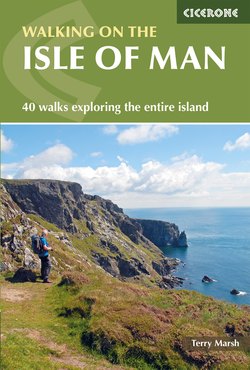Читать книгу Walking on the Isle of Man - Terry Marsh - Страница 15
На сайте Литреса книга снята с продажи.
ОглавлениеWALK 4
Orrisdale and Glen Trunk
| Start/Finish | Orrisdale (SC 327 929) |
| Distance | 4.4km (2¾ miles) |
| Height gain | 55m (180ft) |
| Parking | Limited roadside parking at Orrisdale |
This deceptively simple walk is full of interest and has the advantage of seclusion. It wanders quiet lanes, visits the beach and comes back past one of the great seats of power on the island in times gone by.
The first part of the walk heads down the lane through the scattered hamlet of Orrisdale. Just before the Methodist chapel, a lane branches right at an interesting house with a weather vane and pump. This lane leads to a spot marked on the map as a Cairn.
Also known as the Druid’s Circle, on Cronk Koir, this is a pre-Christian site comprising large quartz boulders set in a circle.
Gorse-lined path through Glen Trunk
Back on the village lane, go past the chapel and follow the lane through a few twists and turns as far as a signed footpath (SC 322 926) branching on the right to the seashore. Beyond a gate a delightful grassy path leads down between gorse bushes towards the shore. This is Glen Trunk, quiet, secluded and little visited. The path leads past a lime kiln finally to reach a shoulder overlooking the beach just south of Orrisdale Head.
Just before reaching the seashore, there is a fine lime kiln tucked neatly into the flank of Glen Trunk. It is one of the largest and most complete to be found on the island. Although not certain, it is likely that the lime would have been brought into the glen by boat and left on the shore for collection and processing.
Here, dip left to cross a wooden footbridge spanning Glen Trunk burn, climbing on the other side to join a vehicle access lane near an isolated cottage. Follow the lane out to meet a surfaced road. Go briefly left and then through a kissing-gate into a field, following a field edge grassy path to a gate at the top of a narrow track, then head downhill to the trackbed of the railway line that once operated along this stretch of coast.
Turn left onto a footpath following the old trackbed, passing behind the impressive building, Bishop’s Court.
Bishop’s Court
BISHOP’S COURT
One of the great houses of interest on the island, Bishop’s Court’s origins are traditionally attributed to Bishop Simon in the 13th century. It was a fortress tower and, in its early days, was moated – the old name for this and the surrounding area was Ballachurrey, which means ‘marshy place’. The first mention of the building occurs in 1231, so there was evidently some significant building on this site before Bishop Simon arrived. In those days, the bishop was a vastly powerful man and, in his own right, a baron, with the power of life and death over his subjects, which gave this outpost something akin to the forts that developed throughout the Border Marches of Wales.
Bishop’s Court was sold into private hands in 1979, so ending more than seven centuries of association with the Diocese of Sodor and Man.
Go onward until the path finally emerges at a lane. Turn left, towards Orrisdale, to complete the walk.
